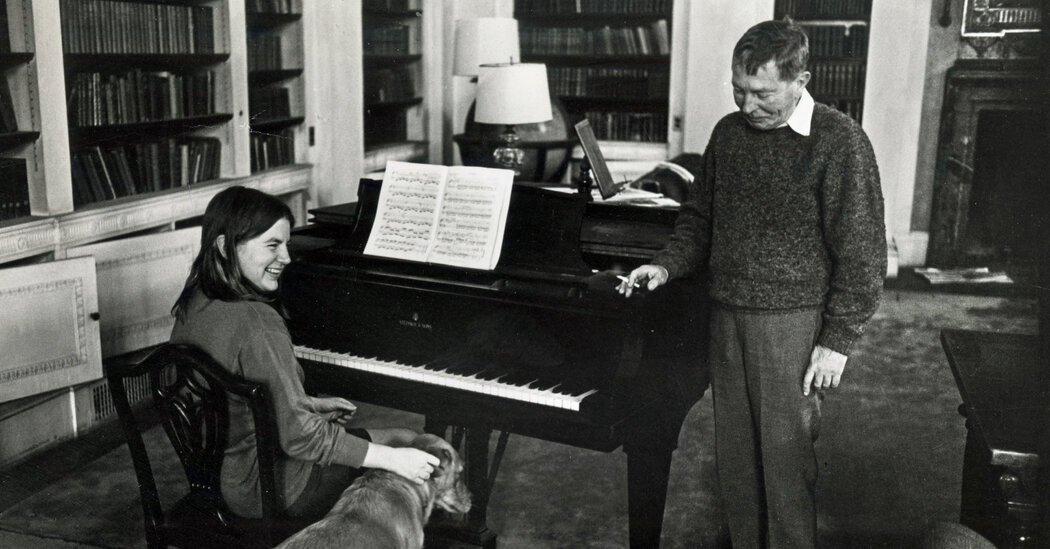=WHEN ALL THE MEN WORE HATS: Susan Cheever on the Stories of John Cheever, by Susan Cheever
Since 1978, “The Stories of John Cheever,” the C swooping grandly over its red cover, has been a crown jewel of American publishing. Now John’s daughter, Susan, has pried some of its precious contents loose, like one of the Louvre burglars, and put them under a loupe.
“When All the Men Wore Hats” is part memoir, part college seminar close-reading exercise (Cheever, who writes across genres, also teaches) — and all wry, twinkling delight. So many girlish exclamation points pinprick the text that I was moved to look up the author’s age: 82! Whoo-hoo.
Susan joined the family business early, to John’s mingled pride and distress. She once interviewed him for the cover of Newsweek. He, always stressed about money, wanted to marry her off to a rich man who would “support us all.” They both conquered drinking problems.
Her 1984 memoir “Home Before Dark” came two years after his death at 70, rushed into print to beat a biographer with revelations about his homosexuality. More than her three previous novels, that book put her on the map.
But then Susan had been on the map since she was a child, part of John’s essential facade as an Ossining “country squire” and, as she makes plain here, tweaked characters in his stories: literary buried treasure.
She pours the hooch down the sink as 10-year-old Amy Lawton in “The Sorrows of Gin”; he breaks her neck with a rope tow lift on a ski trip in “The Hartleys,” a crime Susan avenges in her own “Looking for Work.” And, transformed from a Stendhal-spouting schoolgirl to a hitchhiker with a harp, she sings him through a panic attack driving over the Tappan Zee in “The Angel of the Bridge.”
His journals — a less polished but no less valuable companion to the stories — came out in 1991, with an introduction from one of her younger brothers, Ben. The siblings appear there less than they hoped, and sometimes tinged with the disappointment of being stranger, not as malleable, than fiction.
“As for Susie, she makes the error of daring not to have been invented by me,” John wrote, “of laughing at the wrong times and speaking lines I have not written.”
Ben also became a writer; the younger brother, Federico, a lawyer, died in a rafting accident at 60 in 2017 — a fate unnervingly like that of a Cheever character.
“In a way, he was writing horror stories,” Susan argues, that unfold in mostly American idylls. “Slowly, while the reader is lulled into submission by this gorgeousness, the darkness underneath it all begins to bubble up through the Persian rugs and sleeping retrievers, through the peony hedge and the orchard heavy with apples, and the rolled clay of the tennis courts.”
Like those rugs, John’s alcohol-soaked reputation of repressed gentility has faded somewhat in the autofictional, multicultural, out-and-proud 21st century. But his influence persists, as Susan notes, in work inspired by “The Swimmer,” perhaps his most famous story — including “The Guest,” by Emma Cline, and the long-running television show “Mad Men,” with its adulterous commuters and scorned secretaries (in “The Five Forty-Eight,” one Miss Dent wreaks a #PreToo revenge so indelible, Raymond Carver was roused to write a sequel). “I am Sally Draper twice removed,” she writes.
Even a more recent Jon Hamm vehicle, “Your Friends & Neighbors,” shares plot elements with one of her dad’s many mini-masterpieces, “The Housebreaker of Shady Hill.”
Some of the pleasure of “When All the Men Wore Hats” is simple industry gossip. Susan speculates that the great Knopf editor Robert Gottlieb, who overcame her father’s resistance to repackaging the stories with pomp, loved the ballet and collected plastic purses, “also had some sexual ambivalence.” She relays a hilarious, telling anecdote about her mother working at a Westchester women’s periodical that rejected a John Cheever story submitted with a female pseudonym, one that was later published under his byline by The New Yorker.
Speaking of The New Yorker, which usually happens in hushed tones, she heaps scorn on its decorous editor William Shawn. Under his long tenure the magazine underpaid her father, she writes, balked at publishing “The Swimmer” and wouldn’t give him an office.
A super-Sally moment was when John’s personal editor, William Maxwell, gave her volumes of the Encyclopaedia Britannica to play with on a bench in the hall while the men talked. (“I wouldn’t be bored sitting there! I could learn to recognize the flags of each nation!”) When John finally broke with his longtime editorial home, for which he had once turned down an almost 10-times higher salary from The Saturday Evening Post, he joked darkly that instead of a raise its brass had offered him the keys to the men’s room.
An adverb like “darkly” is one that John, the prince of compression, would have probably excised. “Don’t use dialogue tags” is, his daughter says, the only piece of writing advice he provided. He never wanted to write nonfiction: “Truth was his great enemy,” and so it fell upon his heirs, and others, to expose his secrets. He compared saving letters to preserving kisses and suggested his should be trashed, but Ben ensured the public saw those, too.
“The Cheevers are beginning to suggest revelers who can’t leave the banquet table,” wrote John Updike, John’s dear friend and admirer, in a missive to Maxwell, one of the many Updike letters collected and published this month. Well, pull me up a chair.
WHEN ALL THE MEN WORE HATS: Susan Cheever on the Stories of John Cheever | By Susan Cheever | Farrar, Straus & Giroux | 400 pp. | $30
Alexandra Jacobs is a Times book critic and occasional features writer. She joined The Times in 2010.
The post She’s John Cheever’s Daughter, Except When It Comes to Keeping Secrets appeared first on New York Times.




